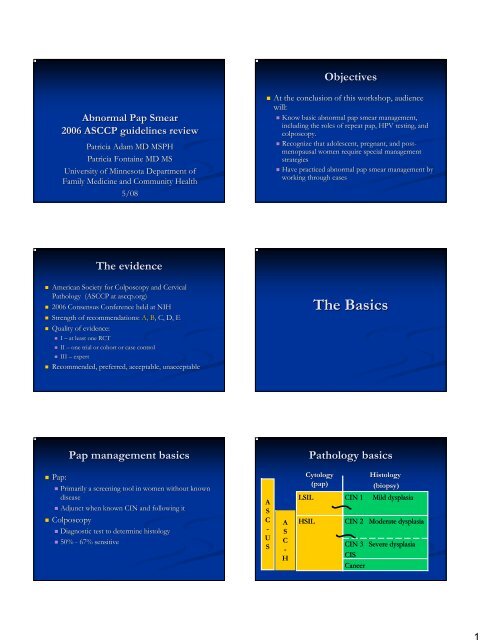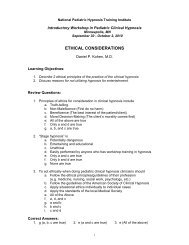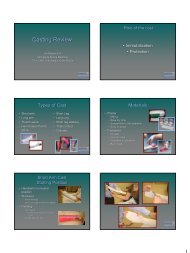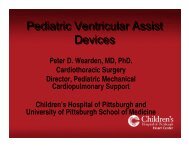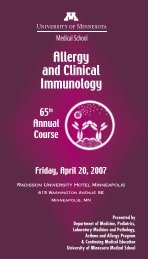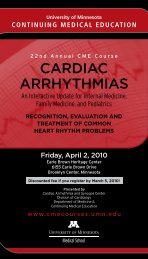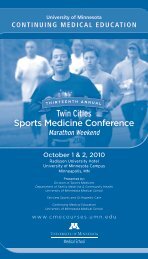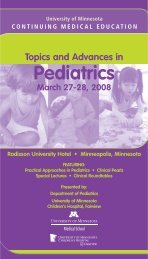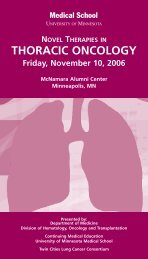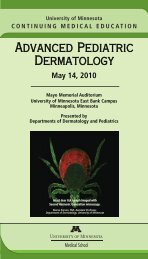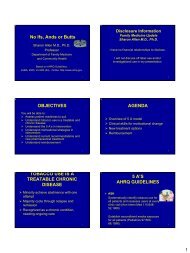Abnormal Pap Smear
Abnormal Pap Smear
Abnormal Pap Smear
Create successful ePaper yourself
Turn your PDF publications into a flip-book with our unique Google optimized e-Paper software.
Objectives<br />
<strong>Abnormal</strong> <strong>Pap</strong> <strong>Smear</strong><br />
2006 ASCCP guidelines review<br />
Patricia Adam MD MSPH<br />
Patricia Fontaine MD MS<br />
University of Minnesota Department of<br />
Family Medicine and Community Health<br />
5/08<br />
• At the conclusion of this workshop, audience<br />
will:<br />
• Know basic abnormal pap smear management,<br />
including the roles of repeat pap, HPV testing, and<br />
colposcopy.<br />
• Recognize that adolescent, pregnant, and post-<br />
menopausal women require special management<br />
strategies<br />
• Have practiced abnormal pap smear management by<br />
working through cases<br />
The evidence<br />
• American Society for Colposcopy and Cervical<br />
Pathology (ASCCP at asccp.org)<br />
• 2006 Consensus Conference held at NIH<br />
• Strength of recommendations: A, B, C, D, E<br />
• Quality of evidence:<br />
• I – at least one RCT<br />
• II – one trial or cohort or case control<br />
• III – expert<br />
• Recommended, preferred, acceptable, unacceptable<br />
The Basics<br />
<strong>Pap</strong> management basics<br />
Pathology basics<br />
• <strong>Pap</strong>:<br />
• Primarily a screening tool in women without known<br />
disease<br />
• Adjunct when known CIN and following it<br />
• Colposcopy<br />
• Diagnostic test to determine histology<br />
• 50% - 67% sensitive<br />
A<br />
S<br />
C<br />
-<br />
U<br />
S<br />
A<br />
S<br />
C<br />
-<br />
H<br />
Cytology<br />
(pap)<br />
Histology<br />
(biopsy)<br />
LSIL CIN 1<br />
Mild dysplasia<br />
HSIL<br />
CIN 2 Moderate dysplasia<br />
CIN 3 Severe dysplasia<br />
CIS<br />
Cancer
<strong>Abnormal</strong> pap smear<br />
management – general<br />
Likelihood of<br />
CIN 2 or CIN 3<br />
General<br />
Management<br />
ASC-US<br />
7 – 12% HPV, pap x2,<br />
colpo<br />
ASC- H 26 - 68% Colposcopy<br />
LSIL 12 – 17% Colposcopy<br />
HSIL 84 – 97% Colposcopy<br />
Special<br />
populations<br />
Yes<br />
No<br />
Yes<br />
No<br />
Principles of Treatment<br />
• Prevent CIN from progressing to cervical cancer<br />
• without increasing complications from over-<br />
treatment<br />
• Decision to treat based on<br />
• Biopsy Diagnosis<br />
• Correlation with <strong>Pap</strong> smear and Colp findings<br />
• Patient age<br />
• Consensus guidelines and clinical judgment<br />
Wright, TC. J of Lower Genital Tract Dis. 2007<br />
Case 1<br />
Cases<br />
• An 18 year old woman presents to your office<br />
with questions about birth control.<br />
• She has been sexually active for three years,<br />
without consistent birth control.<br />
• She has never had a <strong>Pap</strong> smear. She denies<br />
symptoms of sexually transmitted infection.<br />
Case 1<br />
Case 1: <strong>Pap</strong> smear<br />
1. Is a <strong>Pap</strong> smear indicated, based on screening<br />
recommendations?<br />
A. Yes<br />
B. No<br />
“LSIL consistent with CIN 1/mild dysplasia with<br />
features of HPV”
Case 1: Follow up LSIL <strong>Pap</strong><br />
The adolescent: LSIL or ASC- US<br />
Which next steps would be appropriate for<br />
management?<br />
5. Colposcopy<br />
Yes No<br />
6. Repeat <strong>Pap</strong> in 6 months Yes No<br />
B II<br />
7. Repeat <strong>Pap</strong> in 12 months<br />
Yes No<br />
8. Perform HPV in 12 months Yes No<br />
LSIL<br />
Special populations: adolescents<br />
• Defined by ASCCP as under 21<br />
• High prevalence of HPV: 25- 30 %<br />
• Risk for dysplasia increases with early sexual activity,<br />
but risk of cancer is very low – CIN 2/3 has a much<br />
higher rate of regression<br />
• So, recommend:<br />
• NOT to test for HPV<br />
• Delay screening<br />
• Delay colposcopy<br />
• Delay treatment (LEEP increases risk of PTD)<br />
The adolescent: LSIL or ASC- US<br />
Case 1: 12 months later<br />
2 years<br />
No HPV !<br />
• Patient follows up and <strong>Pap</strong> smear is read as<br />
LSIL<br />
• Appropriate next steps in management are<br />
9. Perform reflex HPV testing now Yes No<br />
10. Repeat <strong>Pap</strong> in another 12 months Yes No<br />
11. Recommend colposcopy Yes No
Case 1: 24 months later<br />
• The patient returns a year later and her <strong>Pap</strong><br />
smear is ASC-US.<br />
• Appropriate next steps in management are?<br />
Case 1: Cervix following application<br />
of acetic acid<br />
12. Perform reflex HPV testing now Yes No<br />
13. Repeat <strong>Pap</strong> in another 12 months Yes No<br />
14. Recommend colposcopy Yes No<br />
Case 1: Colposcopic Findings<br />
14. Colposcopic exam suggests a high grade<br />
abnormality.<br />
Y N<br />
15. Endocervical curettage and cervical biopsy<br />
should be performed.<br />
Y N<br />
Case 1: Biopsy Results<br />
• Cervical biopsy shows CIN 1<br />
• Endocervical curettage is negative for abnormal<br />
cells<br />
Case 1: Follow-up CIN 1<br />
CIN I Adolescent<br />
• Appropriate next steps in management are:<br />
15. Repeat <strong>Pap</strong> in 12 months Y N<br />
16. Recommend cryotherapy Y N<br />
17. Recommend LEEP Y N<br />
A II
Case 1: different scenario<br />
• What if her biopsy came back CIN II<br />
• Appropriate management options are:<br />
The adolescent: CIN II/III<br />
Can<br />
observe<br />
18. Repeat <strong>Pap</strong> in 12 months Y N<br />
19. Repeat <strong>Pap</strong> and colpo in 6 months Y N<br />
16. Recommend cryotherapy Y N<br />
17. Recommend LEEP Y N<br />
BIII<br />
Adolescent summary<br />
• Age less than 21<br />
• LSIL, ASCUS and CIN 1 are all followed with<br />
repeat pap smears at 1 year x 2.<br />
• Colposcopy for abnormal pap is only done<br />
when:<br />
• HSIL paps<br />
• 24 months of < HSIL paps and no colposcopy<br />
• Allow for TIME to repair the transient HPV<br />
changes before doing colposcopy<br />
• HPV is no longer recommended for adolescents<br />
Adolescent summary<br />
• CIN I – follow with pap (
Case 2: Follow-up for ASC-H H <strong>Pap</strong><br />
17. Which next step is appropriate for<br />
management?<br />
A. Repeat <strong>Pap</strong> @ 6 and 12 months<br />
B. Perform “reflex” HPV testing<br />
C. Recommend colposcopy<br />
D. All 3 are acceptable, but HPV testing is preferred<br />
E. All 3 are acceptable, but colposcopy is preferred<br />
Case 2: colposcopy<br />
• On colposcopy they noted a low grade<br />
appearing lesion, biopsied it along with 2<br />
random biopsies. Colposcopy exam was<br />
adequate.<br />
• Targeted biopsy: metaplasia<br />
• Random biopsies: CIN I, chronic cervicitis<br />
Case 2: ASC-H H management<br />
18. Appropriate management at this point would<br />
include<br />
A. Repeat HPV in 1 year<br />
B. Referral to gyn for cone since the likelihood of<br />
hidden high grade disease is significant<br />
C. Repeat colpo and pap smear in 6 months<br />
Case 2: ASC – H/CIN I mgmt<br />
BII<br />
Case 3<br />
• A 25 year old woman presents to your office for a<br />
routine pap smear. She is a G1 P0010, and has had two<br />
normal <strong>Pap</strong> smears in the past. She uses the<br />
contraceptive patch for birth control, smokes 1 pack of<br />
cigarettes per day, drinks 6-86<br />
8 beers per weekend, and<br />
admits her diet consists of a lot of “junk food.”<br />
• <strong>Pap</strong> smear is read as “ASC-US.<br />
US.”<br />
• Reflex HPV is positive for high grade types
Case 3: Biopsy Results<br />
• Cervical biopsy @ 0900 CIN 2, moderate<br />
dysplasia<br />
• Cervical biopsy @ 1200 CIN 1,<br />
mild dysplasia<br />
• Endocervical sampling normal<br />
Case 3: Follow-up CIN 2<br />
19. Appropriate recommendation for this<br />
25 year old is:<br />
A. Recommend observation with follow-up <strong>Pap</strong><br />
and colposcopy in 6 months<br />
B. Recommend treatment with cryotherapy<br />
C. Recommend treatment with LEEP<br />
D. Any excisional or ablation treatment is<br />
acceptable, since satisfactory colp with neg ECC<br />
CIN II treatment<br />
Follow-up for CIN-2,3<br />
(with satisfactory colposcopy)<br />
AI<br />
AII<br />
• First time abnormality cryotherapy, laser,<br />
LEEP are all acceptable<br />
• Recurrent CIN 2, 3 excisional procedure is<br />
preferred<br />
• If colposcopy is unsatisfactory need a<br />
diagnostic excisional procedure<br />
• LEEP or cold knife cervical conization
Case 4<br />
• 34 year old presents for annual pap which<br />
returns as HSIL. You recommend she have<br />
colposcopy. Colposcopy was satisfactory<br />
although only a low grade lesion was found.<br />
Random biopsies were done and exam of the<br />
vagina was negative.<br />
• Targeted biopsy: CIN 1<br />
• Random biopsies: CIN 1 and cervicitis<br />
• ECC: negative<br />
Case 4<br />
20. Appropriate management of HSIL with only<br />
CIN 1 on biopsy is:<br />
A. Cone or LEEP since there is lack of correlation<br />
with pap and biopsies.<br />
B. Review with the pathologist the pap smear and the<br />
biopsies<br />
C. Since colpo was satisfactory, ECC was negative<br />
you will observe with 6 month pap and<br />
colposcopies x 2.<br />
D. All of the above<br />
BIII<br />
BII<br />
BIII<br />
CIN 1 preceded by HSIL<br />
Case 5<br />
• 26 year old G3P0002 has her first OB visit. Her<br />
pap returns as LSIL.<br />
• Appropriate management of LSIL in a pregnant<br />
woman is:<br />
21. Colposcopy now Y N<br />
22. Colposcopy post partum Y N<br />
^ except in special populations, + review of pap, colpo and biopsies, * only if satisfactory/ECC neg<br />
Pregnancy and LSIL<br />
Special populations: pregnancy<br />
BII<br />
B III<br />
• Dysplasia is never treated in pregnant women unless<br />
there is cervical cancer with invasion<br />
• Pregnancy does not increase the risk of dysplasia<br />
progression<br />
• Vaginal delivery will often improve mild dysplasia<br />
• May delay colposcopy in pregnant women with ASC-<br />
US +HPV or LSIL until > 6 weeks post partum<br />
• Repeat colposcopy in women with < CIN 2, 3 is not<br />
acceptable
Case 6<br />
• Eunice is a 58 year old woman, with history of<br />
normal pap smears, whose recent pap returned<br />
as LSIL. She is now 3 years postmenopausal<br />
and notes vaginal dryness.<br />
• Appropriate management of LSIL in a<br />
postmenopausal woman is:<br />
23. Colposcopy now Y N<br />
24. Reflex HPV, if +, then colpo Y N<br />
25. Repeat pap in 6 months x 2 Y N<br />
Postmenopausal women<br />
• HPV and CIN 2, 3 much less common<br />
• <strong>Pap</strong> false positive rate higher with atrophy<br />
• Colposcopy is difficult and uncomfortable<br />
• In low risk women, , it is reasonable to do reflex<br />
HPV testing for LSIL and only perform<br />
colposcopy on those with + HPV.<br />
• If history of abnormals, , the risk of cancer is<br />
much higher and colposcopy should be done<br />
Summary<br />
• Management of abnormal pap smears is changing<br />
– more evidence based<br />
• Likelihood of CIN 2 or 3 informs the abnormal<br />
pap smear management strategy<br />
• General population:<br />
• LSIL, ASC-US +HPV, ASC-H H and HSIL: colpo<br />
• Adolescents:<br />
• HSIL and ASC-H:<br />
colpo<br />
• LSIL, ASC-US: pap in 1 year<br />
Summary<br />
• Pregnant women<br />
• LSIL and ASC-US: may defer colpo until after delivery<br />
• Postmenopausal women<br />
• LSIL: may do HPV testing in low risk women to select<br />
those requiring colposcopy<br />
Summary<br />
• Treatment aimed at preventing cervical cancer<br />
without over treatment<br />
• CIN 1<br />
• Don’t t treat (adol(<br />
follow paps, , non-adol<br />
follow HPV)<br />
• CIN 2 and 3<br />
• Treat with LEEP or cryo<br />
• Adolescents: observe CIN 2, treat CIN 3<br />
• HPV – in non adolescents<br />
• ASC-US triage<br />
• For following CIN 1


